Estimating Soil Organic Matter (SOM) Using Proximal Remote Sensing: Performance Evaluation of Prediction Models Adjusted at Local Scale in the Brazilian Cerrado
Abstract
:1. Introduction
2. Materials and Methods
2.1. Study Area
2.2. Soil Samples
2.3. Obtaining the Spectra of Soil Samples
2.4. Data Processing and Statistical Analysis
2.5. Selection of Samples from the Target Area for Recalibration of the Test Area Models
2.6. Evaluation of Local Prediction Models Adjusted for the Test Area
3. Results
3.1. Descriptive Statistics
3.2. Description of Spectral Curves
3.3. Statistical Indices of Predictive Models to Organic Matter
4. Discussion
4.1. Analysis of Spectral Curves
4.2. Local Soil Organic Matter Prediction Models
5. Conclusions
Author Contributions
Funding
Data Availability Statement
Acknowledgments
Conflicts of Interest
References
- Powlson, D.S.; Brookes, P.C.; Whitmore, A.P.; Goulding, K.W.T.; Hopkins, D.W. Soil organic matters. Eur. J. Soil Sci. 2011, 62, 1–4. [Google Scholar]
- Xing, Z.; Du, C.W.; Tian, K.; Ma, F.; Shen, Y.Z.; Zhou, J.M. Application of FTIR-PAS and Raman spectroscopies for the determination of organic matter in farmland soils. Talanta 2016, 158, 262–269. [Google Scholar]
- Hong, Y.; Chen, S.; Zhang, Y.; Chen, Y.; Yu, L.; Liu, Y.; Liu, Y.; Cheng, H.; Liu, Y. Rapid identification of soil organic matter level via visible and near-infrared spectroscopy: Effects of two-dimensional correlation coefficient and extreme learning machine. Sci. Total Environ. 2018, 644, 1232–1243. [Google Scholar]
- Gholizadeh, A.; Boruvka, L.; Saberioon, M.; Vasat, R. Visible, Near-Infrared, and Mid-Infrared Spectroscopy Applications for Soil Assessment with Emphasis on Soil Organic Matter Content and Quality: State-of-the-Art and Key Issues. Appl. Spectrosc. 2013, 67, 1349–1362. [Google Scholar]
- Zeng, R.; Zhao, Y.G.; Li, D.C.; Wu, D.W.; Wei, C.L.; Zhang, G.L. Selection of “local” models for prediction of soil organic matter using a regional soil Vis-NIR spectral library. Soil Sci. 2016, 181, 13–19. [Google Scholar] [CrossRef]
- Lazaar, A.; Mouazen, A.M.; Hammouti, K.E.; Fullen, M.; Pradhan, B.; Memon, M.S.; Andich, K.; Monir, A. The application of proximal visible and near-infrared spectroscopy to estimate soil organic matter on the Triffa Plain of Morocco. Int. Soil Water Conserv. Res. 2020, 8, 195–204. [Google Scholar]
- Viscarra Rossel, R.A.; Behrens, T.; Ben-Dor, E.; Brown, D.J.; Demattê, J.A.M.; Shepherd, K.D.; Shi, Z.; Stenberg, B.; Stevens, A.; Adamchuk, V.; et al. A global spectral library to characterize the world’s soil. Earth-Sci. Rev. 2016, 155, 198–230. [Google Scholar]
- Liu, Y.; Jiang, Q.; Fei, T.; Wang, J.; Shi, T.; Guo, K.; Li, X.; Chen, Y. Transferability of a Visible and Near-Infrared Model for Soil Organic Matter Estimation in Riparian Landscapes. Remote Sens. 2014, 6, 4305–4322. [Google Scholar]
- Heil, K.; Schmidhalter, U. An Evaluation of Different NIR-Spectral Pre-Treatments to Derive the Soil Parameters C and N of a Humus-Clay-Rich Soil. Sensors 2021, 21, 1423. [Google Scholar]
- Madeira Netto, J.S. Comportamento espectral dos solos. In Sensoriamento Remoto—Reflectância dos Alvos Naturais; Meneses, P.R., Madeira Netto, J.S., Eds.; EMBRAPA Cerrados: Brasilia, Brazil, 2001; pp. 127–147. [Google Scholar]
- Demattê, J.A.M.; Epiphanio, J.C.N.; Formaggio, A.R. Influência da matéria orgânica e de formas de ferro na reflectância de solos tropicais. Bragantia 2003, 62, 451–464. [Google Scholar]
- Dalmolin, R.S.D.; Gonçalves, C.N.; Klamt, E.; Dick, D.P. Relação entre os constituintes do solo e seu comportamento espectral. Cienc. Rural 2005, 35, 481–489. [Google Scholar] [CrossRef]
- Cierniewski, J.; Kusnierek, K. Influence of several soil properties on soil surface reflectance. Quaest. Geogr. 2010, 29, 13–25. [Google Scholar] [CrossRef]
- Baumgardner, M.F.; Kristof, S.; Johannsen, C.J.; Zachary, A. Effects of organic matter on the multispectral properties of soils. Soil Sci. 1970, 79, 413–422. [Google Scholar]
- Matews, H.L.; Cunninghan, R.L.; Petersen, G.W. Spectral reflectance of selected Pennsylvania soils. Soil Sci. Soc. Am. Proc. 1973, 37, 421–424. [Google Scholar] [CrossRef]
- Krishman, P.; Alexander, J.D.; Butler, B.J.; Hummel, J.W. Reflectance technique for predicting soil organic matter. Soil Sci. Soc. Am. J. 1980, 44, 1282–1285. [Google Scholar] [CrossRef]
- Chicati, M.S.; Nanni, M.R.; Chicati, M.L.; Furlanetto, R.H.; Cezar, E.; De Oliveira, R.B. Hyperspectral remote detection as an alternative to correlate data of soil constituents. Remote Sens. Appl. Soc. Environ. 2019, 16, 1–8. [Google Scholar]
- Nanni, M.R.; Demattê, J.A.M.; Rodrigues, M.; dos Santos, G.L.A.A.; Reis, A.S.; de Oliveira, K.M.; Cezar, E.; Furlanetto, R.H.; Crusiol, L.G.T.; Sun, L. Mapping Particle Size and Soil Organic Matter in Tropical Soil Based on Hyperspectral Imaging and Non-Imaging Sensors. Remote Sens. 2021, 13, 1782. [Google Scholar]
- Reis, A.S.; Rodrigues, M.; dos Santos, G.L.A.A.; de Oliveira, K.M.; Furlanetto, R.H.; Crusiol, L.G.T.; Cezar, E.; Nanni, M.R. Detection of soil organic matter using hyperspectral imaging sensor combined with multivariate regression modeling procedures. Remote Sens. Appl. Soc. Environ. 2021, 22, 100492. [Google Scholar]
- Cezar, E.; Nanni, M.R.; Crusiol, L.G.T.; Sun, L.; Chicati, M.S.; Furlanetto, R.H.; Rodrigues, M.; Sibaldelli, R.N.R.; Silva, G.F.C.; de Oliveira, K.M.; et al. Strategies for the Development of Spectral Models for Soil Organic Matter Estimation. Remote Sens. 2021, 13, 1376. [Google Scholar]
- Guerrero, C.; Stenberg, B.; Wetterlind, J.; Viscarra Rossel, R.; Maestre, F.; Mouazen, A.; Zornoza, R.; Ruiz-Sinoga, J.; Kuang, B. Assessment of soil organic carbon at local scale with spiked NIR calibrations: Effects of selection and extra-weighting on the spiking subset. Eur. J. Soil Sci. 2014, 65, 248–263. [Google Scholar]
- Qiao, X.X.; Wang, C.; Feng, M.C.; Yang, W.D.; Ding, G.W.; Sun, H.; Liang, Z.Y.; Shi, C.C. Hyperspectral estimation of soil organic matter based on different spectral preprocessing techniques. Spectrosc. Lett. 2017, 50, 156–163. [Google Scholar] [CrossRef]
- Stevens, A.; Nocita, M.; Tóth, G.; Montanarella, L.; van Wesemael, B. Prediction of Soil Organic Carbon at the European Scale by Visible and Near InfraRed Reflectance Spectroscopy. PLoS ONE 2013, 8, e66409. [Google Scholar]
- Viscarra Rossel, R.A.; Webster, R. Predicting soil properties from the Australian soil visible–near infrared spectroscopic database. Eur. J. Soil. Sci. 2012, 63, 848–860. [Google Scholar] [CrossRef]
- Araújo, S.R.; Wetterlind, J.; Demattê, J.A.M.; Stenberg, B. Improving the prediction performance of a large tropical vis-NIR spectroscopic soil library from Brazil by clustering into smaller subsets or use of data mining calibration techniques. Eur. J. Soil Sci. 2014, 65, 718–729. [Google Scholar] [CrossRef]
- Demattê, J.A.M.; Bellinaso, H.; Araujo, S.R.; Rizzo, R.; Souza, A.B. Spectral regionalization of tropical soils in the estimation of soil attributes. Rev. Ciênc. Agron. 2016, 47, 589–598. [Google Scholar] [CrossRef]
- Seidel, M.; Vohlanda, M.; Hutengs, C.; Ludwig, B.; Thiele-Bruhn, S.; Vohland, M. Strategies for the efficient estimation of soil organic carbon at the field scale with vis-NIR spectroscopy: Spectral libraries and spiking vs. local calibrations. Geoderma 2019, 354, 113856. [Google Scholar]
- Shi, Z.; Ji, W.; Viscarra Rossel, R.A.; Chen, S.; Zhou, Y. Prediction of soil organic matter using a spatially constrained local partial least squares regression and the Chinese vis–NIR spectral library. Eur. J. Soil Sci. 2015, 66, 679–687. [Google Scholar] [CrossRef]
- Wetterlind, J.; Stenberg, B.; Söderström, M. Increased sample point density in farm soil mapping by local calibration of visible and near infrared prediction models. Geoderma 2010, 156, 152–160. [Google Scholar]
- Guerrero, C.; Zornoza, R.; Gómez, I.; Mataix-Beneyto, J. Spiking of NIR regional models using simples from target sites: Effect of model size on prediction accuracy. Geoderma 2010, 158, 66–77. [Google Scholar] [CrossRef]
- Dos Santos, P.A.B.; Monti, C.A.U.; de Carvalho, L.G.; Lacerda, W.S.; Schwerz, F. Air temperature estimation techniques in Minas Gerais state, Brazil, Cwa and Cwb climate regions according to the Köppen-Geiger climate classification system. Cienc. Agrotecnol. 2021, 45, e023920. [Google Scholar]
- Ferreira, H.R.; Tres, A.; Tetto, A.F.; Soares, R.V.; Wendling, W.T.; Batista, A.C. Classificação climática para o estado de Minas Gerais segundo as zonas de vida de Holdridge. J. Biotechnol. Biodivers. 2019, 7, 304–314. [Google Scholar]
- CPRM. Mapa Geodiversidades do Brasil: Escala 1:2,500,000: Legenda Expandida; CPRM/Serviço Geológico do Brasil, SGM, MME: Brasilia, Brazil, 2006; 68p.
- World Reference Base for Soil Resources. International Soil Classification System for Naming Soils and Creating Legends for Soil Maps, 3rd ed.; FAO: Rome, Italy, 2014; ISBN 978-92-5-108369-7. [Google Scholar]
- Instituto Agronômico de Campinas IAC. Métodos de Análise Química, Mineralógica e Física de Solos do Instituto Agronômico de Campinas; Boletim 106; Instituto Agronômico de Campinas IAC: Campinas, Brazil, 2009; 77p.
- Empresa Brasileira de Pesquisa Agropecuária—EMBRAPA. Manual de Métodos de Análise de Solo, 3rd ed.; Revista e Ampliada; Embrapa: Rio de Janeiro, Brazil, 2017; 574p. [Google Scholar]
- Labsphere, Inc. Reflectance Calibration Laboratory. Handling Guidelines; Labsphere, Inc. Reflectance Calibration Laboratory: Sutton, UK, 1996. [Google Scholar]
- Rodrigues, M.; Cezar, E.; Argenta, J.C.; Barcelos, L.B.; Reis, A.S.; dos Santos, G.L.A.A.; de Oliveira, K.M.; de Oliveira, R.B.; Nanni, M.R. Relationship Between Vegetation Indices, Nutrients Content, and the Biomass Production of Brachiaria (Brachiaria ruziziensis). Commun. Soil Sci. Plan. 2022, 53, 2400–2419. [Google Scholar]
- Nanni, M.R.; Cezar, E.; Silva Junior, C.A.D.; Silva, G.F.C.; Gualberto, A.A.S. Partial least squares regression (PLSR) associated with spectral response to predict soil attributes in transitional lithologies. Arch. Agron. Soil Sci. 2017, 64, 682–695. [Google Scholar]
- Milos, B.; Bensa, A.; Japundzic-Palenki, B. Evaluation of Vis-NIR preprocessing combined with PLS regression for estimation soil organic carbon, cation exchange capacity and clay from eastern Croatia. Geoderma Reg. 2022, 30, e00558. [Google Scholar]
- Barnes, R.J.; Dhanoa, M.S.; Lister, S.J. Standard normal variate transformation and de-trending of near-infrared diffuse reflectance spectra. Appl. Spectrosc. 1989, 43, 772–777. [Google Scholar]
- Bao, Y.; Ustin, S.; Meng, X.; Zhang, X.; Guan, H.; Qi, B.; Liu, H. A regional-scale hyperspectral prediction model of soil organic carbon considering geomorphic features. Geoderma 2021, 403, 115263. [Google Scholar]
- Li, L.; Lu, J.; Wang, S.; Ma, Y.; Wei, Q.; Li, X.; Cong, R.; Ren, T. Methods for estimating leaf nitrogen concentration of winter oilseed rape (Brassica napus L.) using in situ leaf spectroscopy. Ind. Crops Prod. 2016, 91, 194–204. [Google Scholar]
- Veum, K.; Sudduth, K.A.; Kremer, R.J.; Kitchen, N.R. Estimating a soil quality index with VNIR reflectance spectroscopy. Soil Sci. Soc. Am. J. 2015, 2, 637–649. [Google Scholar]
- Thomas, F.; Petzold, R.; Landmark, S.; Mollenhauer, H.; Becker, C.; Werban, U. Estimating Forest Soil Properties for Humus Assessment—Is Vis-NIR the Way to Go? Remote Sens. 2022, 14, 1368. [Google Scholar]
- Cezar, E.; Luiz Cruciol, L.G.T.; Nanni, M.R.; Guerrero, C.; da Silva Junior, C.A.; Chicati, M.A.; Silva, G.F.C. Organic matter and sand estimates by spectroradiometry: Strategies for the development of models with applicability at a local scale. Geoderma 2019, 340, 224–233. [Google Scholar]
- Naes, T.; Isaksson, T.; Fearn, T.; Davies, T. A User-Friendly Guide to Multivariate Calibration and Classification; Nir Publication: Chichester, UK, 2004; 335p. [Google Scholar]
- Guy, A.L.; Siciliano, S.D.; Lamb, E.G. Spiking regional VIS-NIR calibration models with local samples to predict soil organic carbon in two High Arctic polar deserts using a Vis-NIR probe. Can. J. Soil Sci. 2015, 95, 237–249. [Google Scholar] [CrossRef]
- Guerrero, C.; Wetterlind, J.; Stenberg, B.; Mouazen, A.M.; Gabarrón-Galeote, M.A.; RuizSinoga, J.D.; Zornoza, R.; Viscarra Rossell, R.A. Do we really need large spectral libraries for local scale SOC assessment with NIR spectroscopy? Soil Till. Res. 2016, 155, 501–509. [Google Scholar] [CrossRef]
- Hong, Y.; Chen, Y.; Zhang, Y.; Liu, Y.; Liu, Y.; Yu, L.; Liu, Y.; Cheng, H. Transferability of Vis-NIR models for Soil Organic Carbon Estimation between Two Study Areas by using Spiking. Soil Sci. Soc. Am. J. 2018, 82, 1231–1242. [Google Scholar] [CrossRef]
- Bellom-Maurel, V.; Ahumada, E.F.; Palagos, B.; Roger, J.M.; Mcbratney, A. Critical review of chemometric indicators commonly used for assessing the quality of the prediction of soil atributes by NIR spectroscopy. TrAC Trend Anal. Chem. 2010, 29, 1073–1081. [Google Scholar] [CrossRef]
- Demattê, J.A.M.; Bellinaso, H.; Romero, D.J.; Fongaro, C.T. Morphological Interpretation of Reflectance Spectrum (MIRS) using libraries looking towards soil classification. Sci. Agric. 2014, 71, 509–520. [Google Scholar] [CrossRef]
- Ten Caten, A.; Dalmolin, R.S.D.; da Silva, E.B.; Heinen, T.Z.H.; Safanelli, J.L. Avanços na observação e no conhecimento do solo via o sensoriamento próximo. Agropecuária Catarin. 2021, 34, 72–78. [Google Scholar] [CrossRef]
- Demattê, J.A.M.; Araújo, S.M.; Fiorio, P.R.; Fongaro, C.T.; Nanni, M.R. VIS-NIR-SWIR na avaliação de solos ao longo de uma topossequência em Piracicaba (SP). Ver. Cienc. Agron. 2015, 46, 679–688. [Google Scholar] [CrossRef]
- Poppiel, R.R.; Lacerda, M.P.C.; de Oliveira Junior, M.P.; Demattê, J.A.M.; Romero, D.J.; Sato, M.V.; de Almeida Júnior, L.R.; Cassol, L.F.M. Surface Spectroscopy of Oxisols, Entisols and Inceptisol and Relationships with Selected Soil Properties. Rev. Bras. Cienc. Solo 2018, 42, 1–26. [Google Scholar] [CrossRef]
- Rodrigues, M.; Nanni, M.R.; Cezar, E.; dos Santos, G.L.A.A.; Reis, A.S.; de Oliveira, K.M. Evaluation of the use of spectroradiometry for the determination of soil exchangeable ions after the application of mining coproducts. Appl. Spectrosc. Rev. 2019, 55, 491–508. [Google Scholar] [CrossRef]
- Nawar, S.; Mouazen, A.M. Optimal sample selection for measurement of soil organic carbon using online Vis-NIR spectroscopy. Comput. Electron. Agric. 2018, 151, 469–477. [Google Scholar] [CrossRef]
- Viscarra Rossel, R.A.; Behrens, T. Using data mining to model and interpret soil diffuse reflectance spectra. Geoderma 2010, 158, 46–54. [Google Scholar] [CrossRef]
- Rosero-Vlasova, O.A.; Vlassova, L.; Pérez-Cabello, F.; Montorio, R.; Nadal-Romero, E. Soil organic matter and texture estimation from visible–near infrared–shortwave infrared spectra in areas of land cover changes using correlated component regression. Land Degrad. Dev. 2019, 30, 544–560. [Google Scholar] [CrossRef]
- Nawar, S.; Mouazen, A.M. Predictive performance of mobile vis-near infrared spectroscopy for key soil properties at different geographical scales by using spiking and data mining techniques. Catena 2017, 151, 118–129. [Google Scholar] [CrossRef]
- Ramirez-Lopez, L.; Behrens, T.; Schmidt, K.; Viscarra Rossel, R.A.; Demattê, J.A.M.; Scholten, T. Distance and similarity-search metrics for use with soil vis–NIR spectra. Geoderma 2013, 199, 43–53. [Google Scholar] [CrossRef]
- Sá, J.C.M.; Séguy, L.; Gozé, E.; Bouzina, S.; Bouzinac, S.; Husson, O.; Boulaki, S.; Tivet, F.; Forest, F.; dos Santos, J.B. Carbon sequestration rates in no-tillage soils under intensive cropping systems in tropical agroecozones. Edafologia 2006, 13, 139–150. [Google Scholar]
- Paz-Kagan, T.; Zaady, E.; Salbach, C.; Schmidt, A.; Lausch, A.; Zacharias, S.; Notesco, G.; Ben-Dor, E.; Karnieli, A. Mapping the spectral soil quality index (SSQI) using airborne imaging spectroscopy. Remote Sens. 2015, 7, 15748–15781. [Google Scholar] [CrossRef]
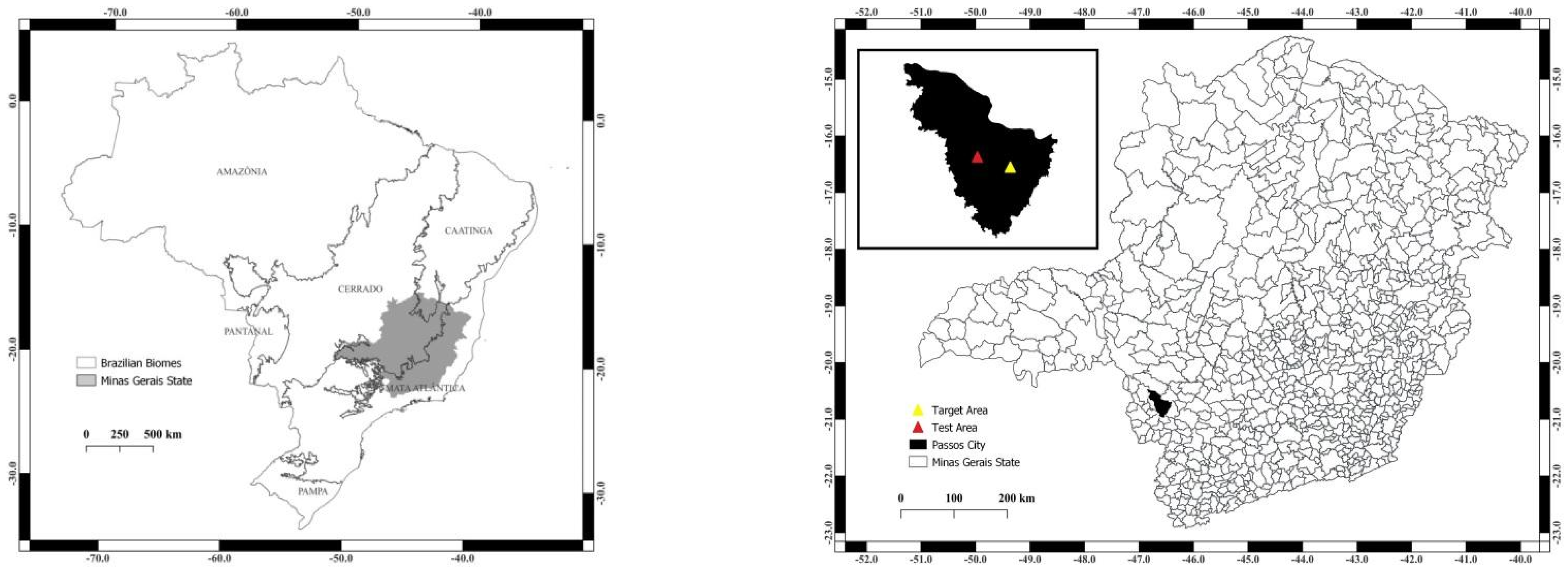
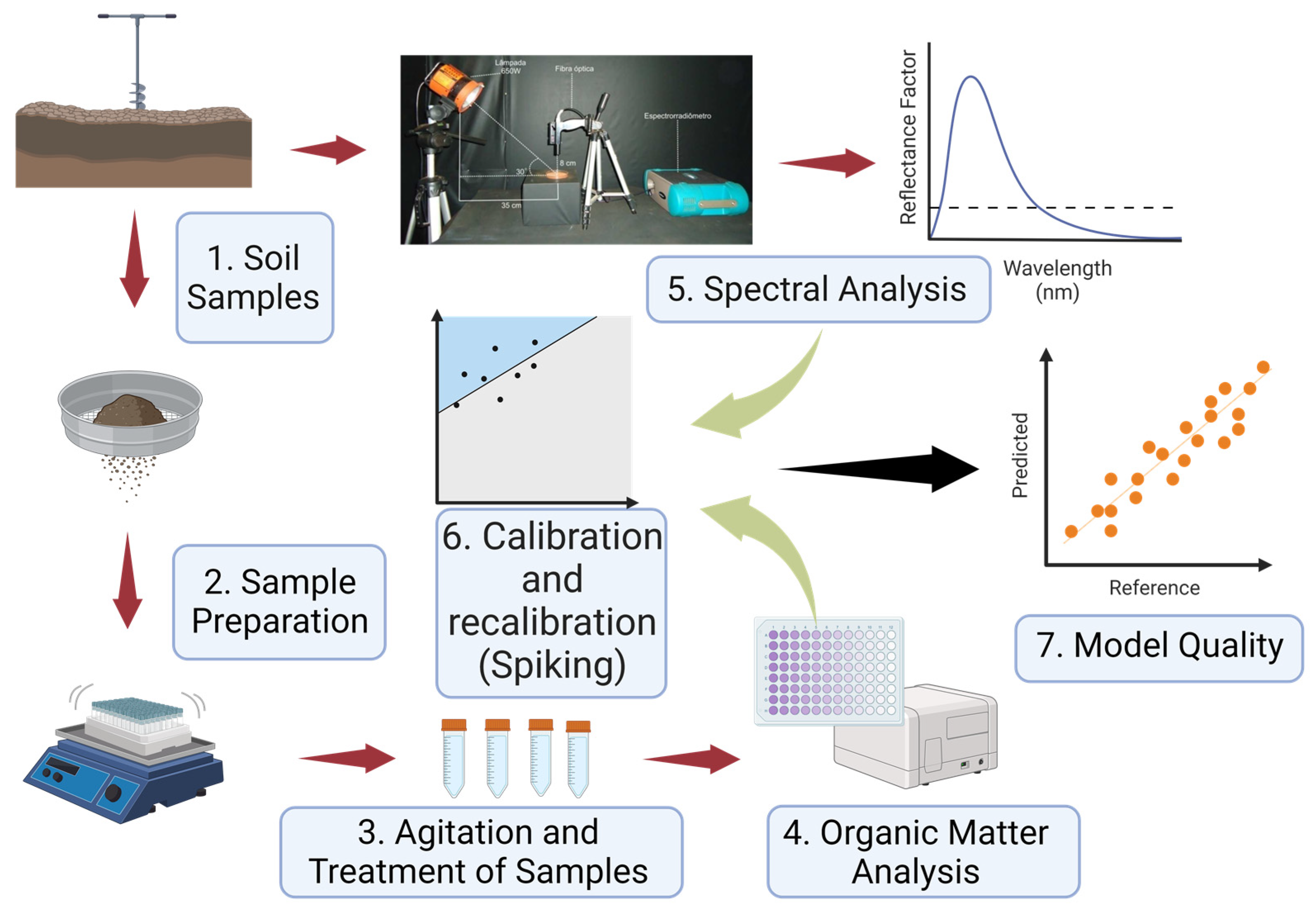




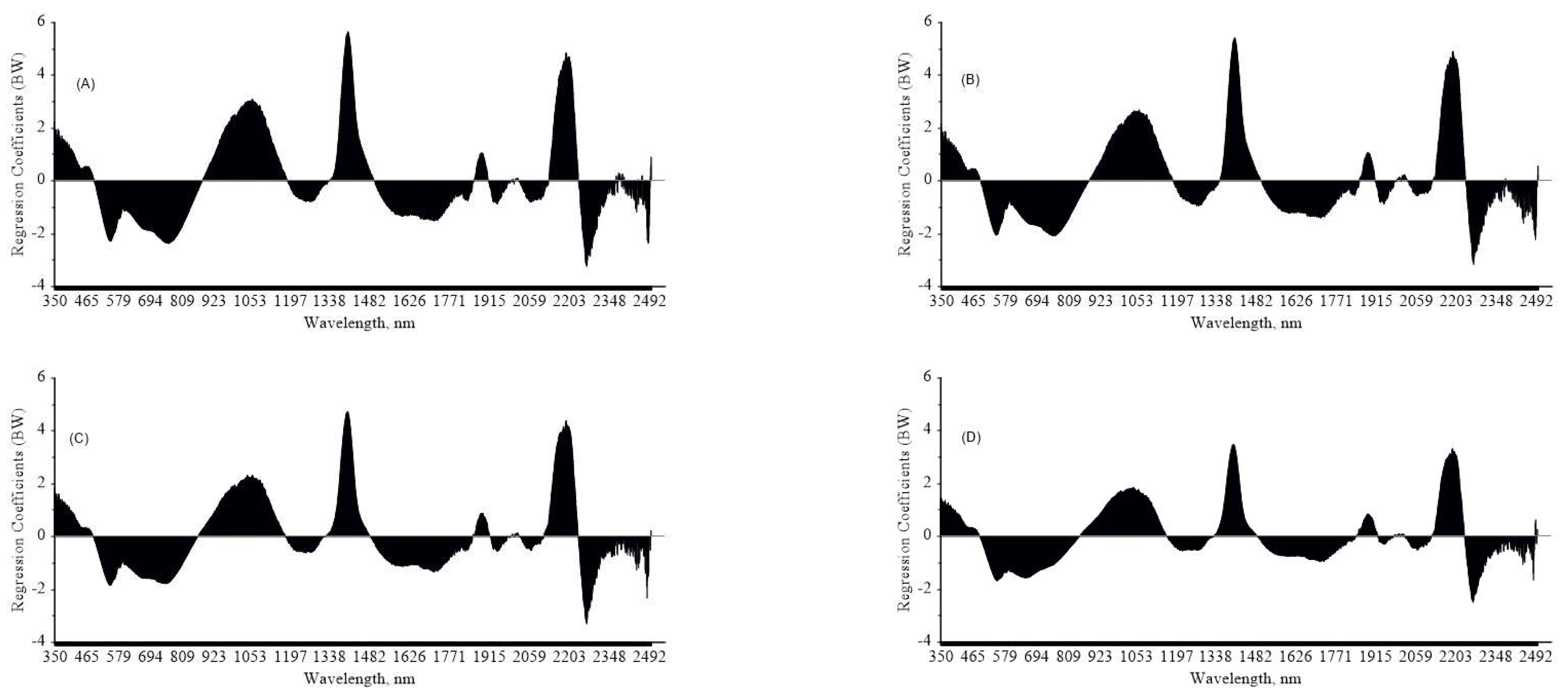
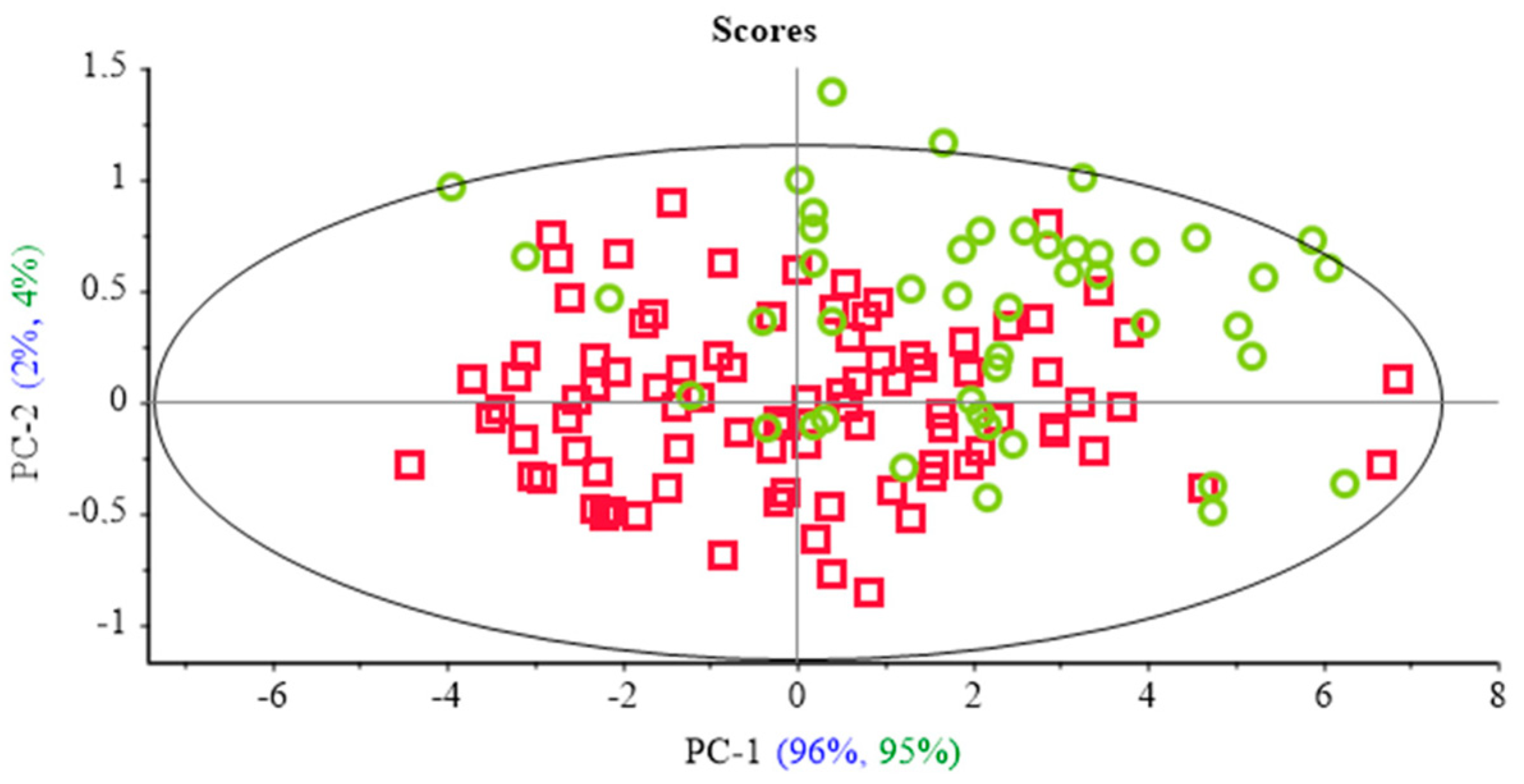
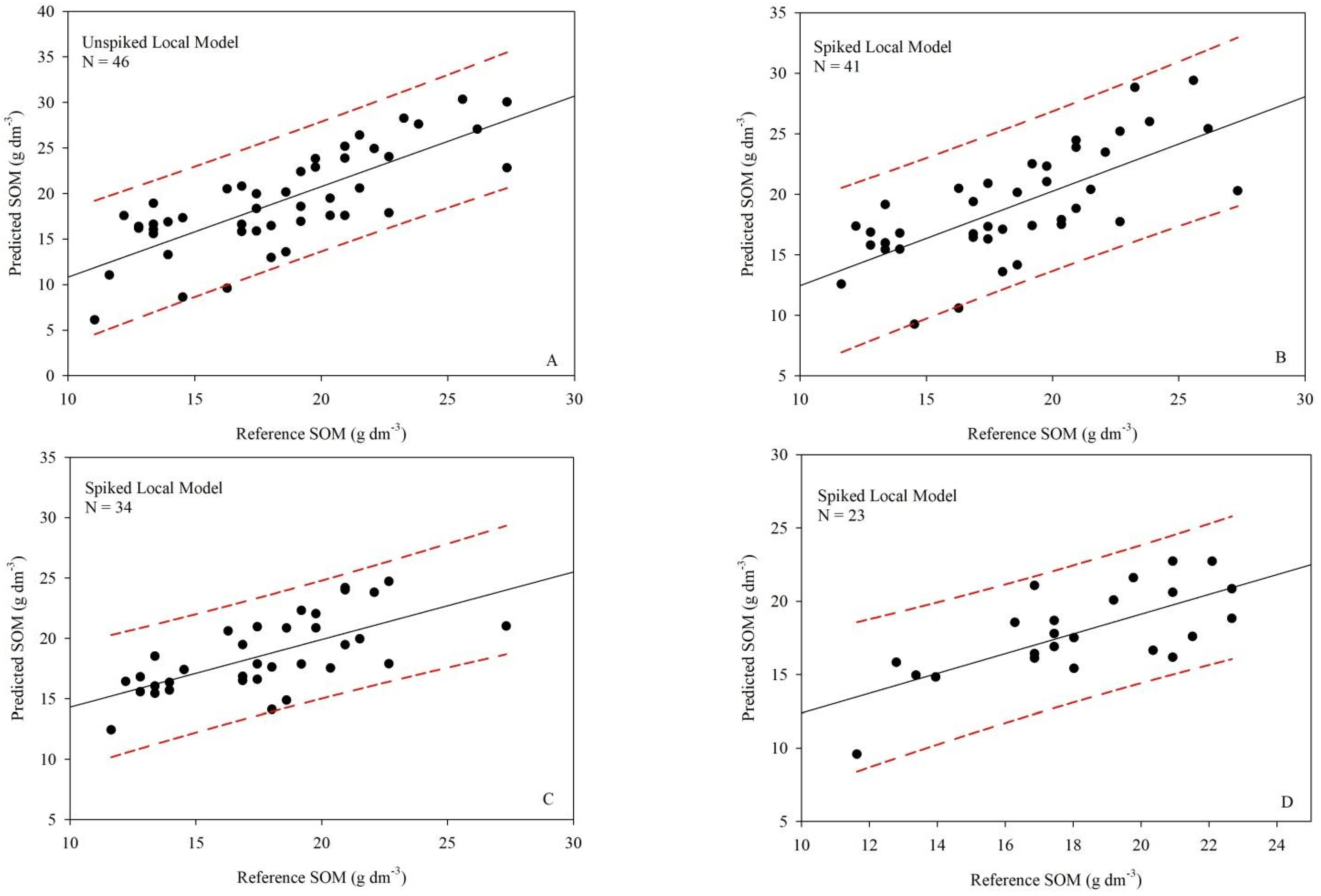
| Area | Mean | Standard Deviation | Minimum | Maximum | Kurtosis | Skewness | Swilk W | Swilk Prob |
|---|---|---|---|---|---|---|---|---|
| g dm−3 | ||||||||
| Test | 19.58 | 6.20 | 10 | 36 | −0.23 | 0.61 | 0.96 | 0.006 |
| Target | 31.37 | 7.36 | 19 | 47 | −0.58 | 0.33 | 0.97 | 0.24 |
| Description | N | r2 | RMSEC (g dm−3) | RMSECV (g dm−3) | RMSEP (g dm−3) | BIAS * | RPIQ * |
|---|---|---|---|---|---|---|---|
| Calibration | 89 | 0.95 | 4.56 | - | - | −0.31 | 1.97 |
| Cross-validation | 89 | 0.94 | - | 4.96 | - | −0.27 | 1.81 |
| Prediction | 46 | 0.31 | - | - | 3.50 | 0.77 | 3.14 |
| Recalibration | 94 | 0.95 | 4.45 | - | - | −0.30 | 2.02 |
| Cross-validation | 94 | 0.94 | - | 4.93 | - | −0.24 | 1.82 |
| Prediction | 41 | 0.31 | - | - | 3.31 | 0.63 | 3.32 |
| Recalibration | 101 | 0.96 | 4.05 | - | - | −0.27 | 2.22 |
| Cross-validation | 101 | 0.95 | - | 4.50 | - | −0.24 | 2.00 |
| Prediction | 34 | 0.34 | - | - | 2.92 | 0.91 | 3.76 |
| Recalibration | 112 | 0.96 | 3.88 | - | - | −0.26 | 2.31 |
| Cross-validation | 112 | 0.95 | - | 4.20 | - | −0.22 | 2.62 |
| Prediction | 23 | 0.43 | - | - | 2.34 | −0.27 | 4.58 |
Disclaimer/Publisher’s Note: The statements, opinions and data contained in all publications are solely those of the individual author(s) and contributor(s) and not of MDPI and/or the editor(s). MDPI and/or the editor(s) disclaim responsibility for any injury to people or property resulting from any ideas, methods, instructions or products referred to in the content. |
© 2023 by the authors. Licensee MDPI, Basel, Switzerland. This article is an open access article distributed under the terms and conditions of the Creative Commons Attribution (CC BY) license (https://creativecommons.org/licenses/by/4.0/).
Share and Cite
Cezar, E.; Alberton, T.A.; Lemos, E.F.; de Oliveira, K.M.; Sun, L.; Crusiol, L.G.T.; Rodrigues, M.; Reis, A.S.; Nanni, M.R. Estimating Soil Organic Matter (SOM) Using Proximal Remote Sensing: Performance Evaluation of Prediction Models Adjusted at Local Scale in the Brazilian Cerrado. Remote Sens. 2023, 15, 4397. https://doi.org/10.3390/rs15184397
Cezar E, Alberton TA, Lemos EF, de Oliveira KM, Sun L, Crusiol LGT, Rodrigues M, Reis AS, Nanni MR. Estimating Soil Organic Matter (SOM) Using Proximal Remote Sensing: Performance Evaluation of Prediction Models Adjusted at Local Scale in the Brazilian Cerrado. Remote Sensing. 2023; 15(18):4397. https://doi.org/10.3390/rs15184397
Chicago/Turabian StyleCezar, Everson, Tatiane Amancio Alberton, Evandro Freire Lemos, Karym Mayara de Oliveira, Liang Sun, Luís Guilherme Teixeira Crusiol, Marlon Rodrigues, Amanda Silveira Reis, and Marcos Rafael Nanni. 2023. "Estimating Soil Organic Matter (SOM) Using Proximal Remote Sensing: Performance Evaluation of Prediction Models Adjusted at Local Scale in the Brazilian Cerrado" Remote Sensing 15, no. 18: 4397. https://doi.org/10.3390/rs15184397






